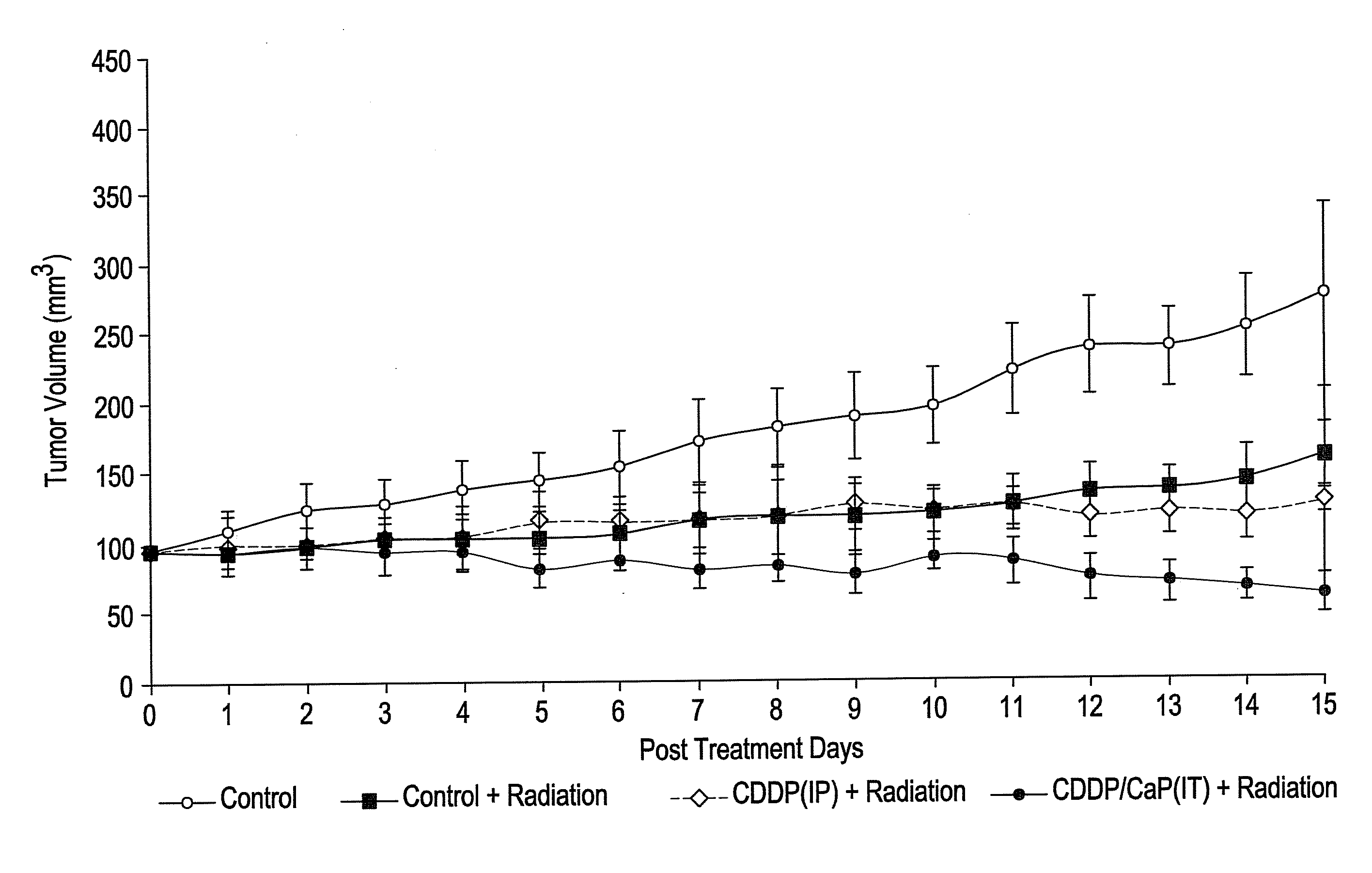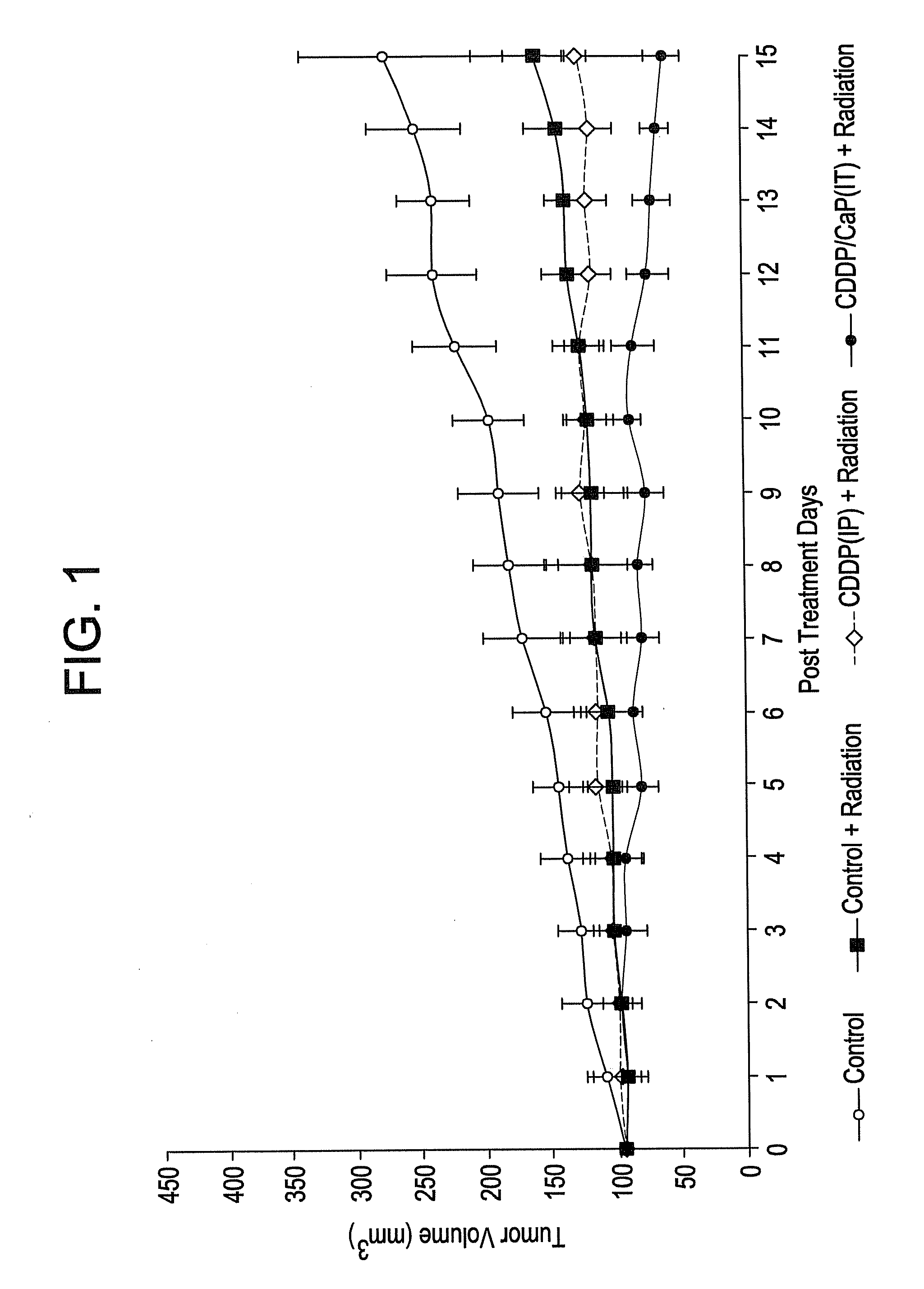Targeted active agent delivery system based on calcium phosphate nanoparticles
- Summary
- Abstract
- Description
- Claims
- Application Information
AI Technical Summary
Benefits of technology
Problems solved by technology
Method used
Image
Examples
example 1
Preparation of Calcium Phosphate Particles; Calcinated Particles
[0065]Calcium phosphate particles were synthesized by the rapid mixture of two solutions: calcium nitrate and sodium bicarbonate / ammonium phosphate. The calcium nitrate solution is prepared by the addition of 500 ml of deionized distilled water to 42.07 g of calcium nitrate tetrahydrate. The sodium bicarbonate / ammonium phosphate solution is prepared by the combination of 80 g of ammonium phosphate dibasic, 40 g of sodium bicarbonate and 1 L of deionized distilled water. The calcium nitrate solution is poured into the sodium bicarbonate / ammonium phosphate solution and let to mature at 25° C. for 7 days. The precipitate formed was then filtered and lyophilized for 3-4 days. Upon completion of lyophilization, the crystals where then calcinated for 5 hours at 200° C. and finally sieved to obtain crystals smaller than 45 μm.
[0066]The structure and composition of the calcium phosphate particles were confirmed as pure hydroxya...
example 2
Preparation of Calcium Phosphate Nanoparticles; Particles Prepared in the Presence of a Dispersing Agent
[0074]Calcium phosphate nanoparticles were synthesized by precipitation from the addition of equal volumes of a 30 mM Ca(NO3)2 solution and a 30 mM K2HPO4 solution which are both filtered through 0.1 μm filtration device (Millipore, Boston, USA) separately, followed by immediate addition of 1.67 (v / v) % of 0.2 μm filtered DARVAN®811 (sodium polymethacrylate, MW=3,300, R.T. Vanderbilt Company, Inc. Norwalk, Conn., USA) as a dispersing agent. All reagents are ACS grade and purchased from Sigma Chemical Co., (St. Louis, Mo.), unless noted otherwise. After 1 hr stirring, a pellet of calcium phosphate nanoparticles was collected by centrifugation at 12,000 rpm (20,076 g) for 30 minutes. Before conjugate formation, the calcium phosphate nanoparticle pellet was redispersed in ultrapure H2O as a wash step, and then collected by centrifugation at 12,000 rpm for 30 minutes. Stably dispersed...
example 3
Comparison of Calcium Phosphate Nanoparticle Prepared in the Presence of a Dispersing Agent and Calcium Phosphate Particles, Micrometer-Sized
[0095]Calcium phosphate nanoparticles were compared to calcium phosphate micrometer-sized particles for their in vitro active agent release properties. Calcium phosphate nanoparticles were prepared by the addition of Darvan during the calcium phosphate precipitation similar to Example 2 above. After a 1 hr reaction time, dispersed 119 nm particulates were collected. The micro- and nanoparticles were characterized TEM, FTIR, XRD, particle size analysis and zeta potential measurements. Complexes of the calcium phosphate particles and cisplatin were prepared through electrostatic binding of an aquated species of cisplatin to the calcium phosphate particles in a chloride-free phosphate buffer. The active agent loading was determined by platinum atomic absorption spectroscopy. Active agent release studies were completed at 4 hours, 1 day, 3 days, 7 ...
PUM
| Property | Measurement | Unit |
|---|---|---|
| Particle diameter | aaaaa | aaaaa |
| Particle diameter | aaaaa | aaaaa |
Abstract
Description
Claims
Application Information
 Login to View More
Login to View More - Generate Ideas
- Intellectual Property
- Life Sciences
- Materials
- Tech Scout
- Unparalleled Data Quality
- Higher Quality Content
- 60% Fewer Hallucinations
Browse by: Latest US Patents, China's latest patents, Technical Efficacy Thesaurus, Application Domain, Technology Topic, Popular Technical Reports.
© 2025 PatSnap. All rights reserved.Legal|Privacy policy|Modern Slavery Act Transparency Statement|Sitemap|About US| Contact US: help@patsnap.com



